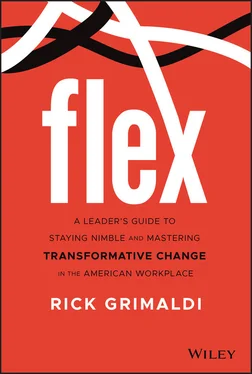Let's consider them one at a time.
The Face of America Is Changing
One of the biggest changes sweeping our nation is the pace of diversity. The percentage of white Americans is shrinking. In fact, by the year 2045, the census projects that whites will make up just under half of the US population, officially making them a minority. America will also be almost one-quarter Hispanic and nearly 8% Asian. 1
Where will US population growth come from exactly? International migration. As the largely white population retires, it will be youthful minorities who take their place. By 2060, the census estimates that only 36% of those under 18 will be white. Non-whites already make up the majority of newborns and kids in K–12 schools in the US today.
The political schism in America today makes sense in this context, doesn't it? The on-the-ground realities are quite different for the declining white population and the emerging multiracial population. As America rapidly becomes more ethnically diverse, companies will need to recognize resistance to change among the ranks, become adept at fostering acceptance and inclusion, and actively work to effectively engage a diverse workforce.
Paying lip service to “diversity initiatives” will brand organizations as out-of-step, making it more challenging to recruit talent. As you will learn, what really matters instead is consistent hiring practices that actually reflect an inclusive and diverse workforce.
When a potential hire looks around the office or the plant, what are they noting about your organization? Is the executive team elderly, male, and white? Or does it accurately reflect the diverse racial and gender makeup that is their reality? Here's a tantalizing stat to consider: in 2019, 60% of companies in the US did not have a single woman on the board. 2
Also, senior citizens are soon expected to outnumber children for the first time in our history. In just one decade from now—by 2030—every baby boomer will be at least 65 years old, ushering in a radical new era of slower population growth. 3 In fact, by 2060, there will be just 2.5 workers (down from 3.5 workers) to drive the economy for every retired individual. 4
Millennials Are Taking Over
Recently, millennials surpassed Gen Xers as the largest generation of workers. 5 And that trend has plenty of critical implications as well. Just as America is experiencing a widening gap between whites and non-whites, so, too, is it struggling with a schism between the experience of older Americans and millennials.
Millennials are early adopters of technology. Unlike their older peers, they've grown up with the internet in a connected society replete with social media and other online solutions oriented platforms. Technology solutions are intuitive for them.
At first glance, it might seem millennials have a societal advantage due to their facility with technology compared to older generations. But, although they may find it easier to navigate the latest app or trending technology, they are also less at ease with real-time communication than older Americans. This is true in the workplace as well. In other words, even as they are more connected, they are also more dis connected.
Millennials are struggling in other ways, too. The American Dream they've watched their parents embrace is fading from view. It seems unattainable for millennials as they struggle under the burden of historic loan debt, soaring health care costs, and flattened wages, forcing many to live at home well into their 30s.
Sets of couples are sharing tiny apartments in large urban cities with runaway housing costs and forgoing consumer purchases such as new cars that previous generations took for granted as a normal perk of life after college. Millennials are realizing that, for the first time in history, they are unlikely to do as well as their parents have done.
Will those resentments play out in unforeseen ways as they ultimately arrive in the C suite and must allocate financial resources for older generations? If not millennials, who will drive the economic engine as baby boomers retire and reduce spending?
Ultimately, it's in the workplace (as well as society at large) where these generational trends often work at cross-purposes when workers' values and communication styles conflict. Successful companies will be those who can flex and find creative ways to harness the diverse strengths of their employees in service of the company's goals.
Education Isn't Training for Reality
How exactly will we prepare and train students for this new and ever-shifting work landscape? Unfortunately, our nation's educational systems are training for a reality that no longer exists. Teaching is outmoded.
Education also must change to respond to the changes in American demographics we've been discussing. Universities are combatting declining enrollment trends, which causes a cascade of consequences reshaping American education.
Why is college enrollment down? In part, because the national birth rate is down: 20% since the 2008 recession, 6 actually. For millennials, it's not just a question of how to afford a home and a new car; this generation has no idea how they will pay for health care and childcare, much less a college education for their progeny.
In short, they can't afford to have kids. That's a big reason why fertility rates are at a record low. And if we look forward 18 years from that decision to forgo a pregnancy, we can expect to see a major decline in college admissions beginning in around 2026. 7
It's not surprising, right? Fewer babies means fewer college freshman. But how will universities fill their enrollment quotas when their financial model is under stress? Perhaps with an increasing number of international students as many do now?
These kinds of demographic trends are already putting education on a collision course with the future as we know it. Traditional college markets—such as white students from economically privileged families in the Northeast—are being replaced by an increase in Hispanics in the Southwest who, for a variety of reasons, may be less sold on the value of a college education. 8
For many white students from middle- and upper-class families, college has always been an important steppingstone to an enriching career or well-paying job. But the Hispanic college market is far softer. These students are less likely to enroll in a selective college in the first place, and if they do enroll at all, for a variety of reasons, they are less likely to attend full-time. 9
Another reason there are fewer students heading to college: there are fewer kids graduating from high school. Illiteracy is becoming an increasing problem. In urban areas, where students frequently struggle with poverty and food security, a high school degree doesn't seem that compelling when it's easier to get a job in retail in order to earn money to live. So it may not surprise you to learn that forecasts suggest an 11% decrease in first-time college goers by the end of the 2020s. 10
You might think universities would respond to this declining market by cutting prices, but that seems unlikely given that reducing revenue doesn't offer a net economic gain to compensate for fewer students. And here's another thing to consider as we wonder what the future of education will look like: how important is it to be a college graduate to succeed in tomorrow's workforce?
And if it's important, is a two-year community college degree enough? What's the best return on investment for students based on the considerable expense of an American college degree?
The answer to each of those questions is that it depends on where you live and what you want to do. It also depends on the ability of forward-thinking educational institutions to anticipate the needs of specific skill sets in local industries that are reinventing themselves again and again as new technologies accelerate the way they do business so they create true value for their students. In short, college as we know it is under tremendous pressure to flex.
Читать дальше












